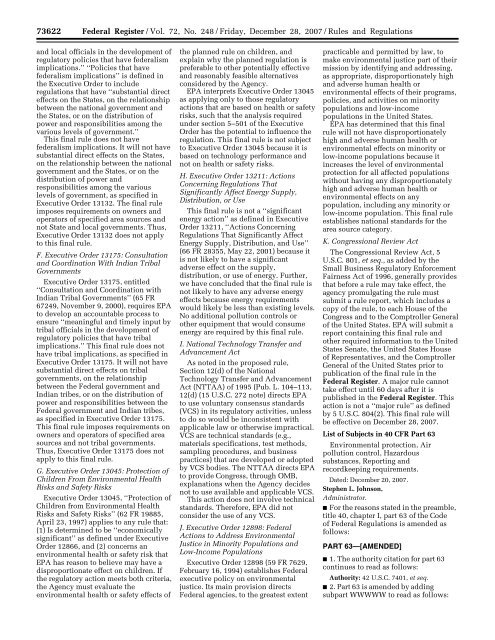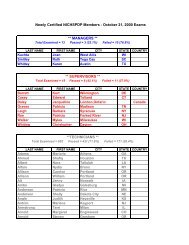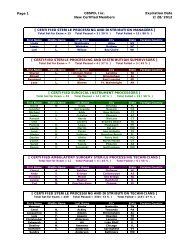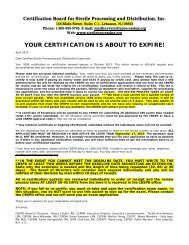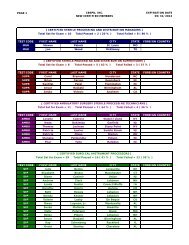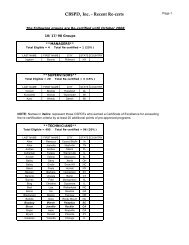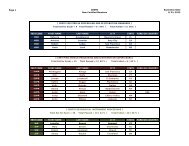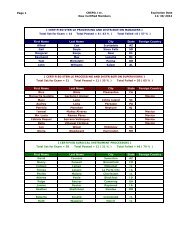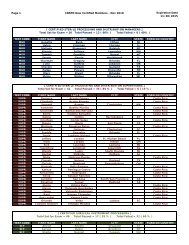Hospitals: Ethylene Oxide Sterilizers - US Environmental Protection ...
Hospitals: Ethylene Oxide Sterilizers - US Environmental Protection ...
Hospitals: Ethylene Oxide Sterilizers - US Environmental Protection ...
You also want an ePaper? Increase the reach of your titles
YUMPU automatically turns print PDFs into web optimized ePapers that Google loves.
73622 Federal Register / Vol. 72, No. 248 / Friday, December 28, 2007 / Rules and Regulationspwalker on PROD1PC71 with RULESand local officials in the development ofregulatory policies that have federalismimplications.’’ ‘‘Policies that havefederalism implications’’ is defined inthe Executive Order to includeregulations that have ‘‘substantial directeffects on the States, on the relationshipbetween the national government andthe States, or on the distribution ofpower and responsibilities among thevarious levels of government.’’This final rule does not havefederalism implications. It will not havesubstantial direct effects on the States,on the relationship between the nationalgovernment and the States, or on thedistribution of power andresponsibilities among the variouslevels of government, as specified inExecutive Order 13132. The final ruleimposes requirements on owners andoperators of specified area sources andnot State and local governments. Thus,Executive Order 13132 does not applyto this final rule.F. Executive Order 13175: Consultationand Coordination With Indian TribalGovernmentsExecutive Order 13175, entitled‘‘Consultation and Coordination withIndian Tribal Governments’’ (65 FR67249, November 9, 2000), requires EPAto develop an accountable process toensure ‘‘meaningful and timely input bytribal officials in the development ofregulatory policies that have tribalimplications.’’ This final rule does nothave tribal implications, as specified inExecutive Order 13175. It will not havesubstantial direct effects on tribalgovernments, on the relationshipbetween the Federal government andIndian tribes, or on the distribution ofpower and responsibilities between theFederal government and Indian tribes,as specified in Executive Order 13175.This final rule imposes requirements onowners and operators of specified areasources and not tribal governments.Thus, Executive Order 13175 does notapply to this final rule.G. Executive Order 13045: <strong>Protection</strong> ofChildren From <strong>Environmental</strong> HealthRisks and Safety RisksExecutive Order 13045, ‘‘<strong>Protection</strong> ofChildren from <strong>Environmental</strong> HealthRisks and Safety Risks’’ (62 FR 19885,April 23, 1997) applies to any rule that:(1) Is determined to be ‘‘economicallysignificant’’ as defined under ExecutiveOrder 12866, and (2) concerns anenvironmental health or safety risk thatEPA has reason to believe may have adisproportionate effect on children. Ifthe regulatory action meets both criteria,the Agency must evaluate theenvironmental health or safety effects ofthe planned rule on children, andexplain why the planned regulation ispreferable to other potentially effectiveand reasonably feasible alternativesconsidered by the Agency.EPA interprets Executive Order 13045as applying only to those regulatoryactions that are based on health or safetyrisks, such that the analysis requiredunder section 5–501 of the ExecutiveOrder has the potential to influence theregulation. This final rule is not subjectto Executive Order 13045 because it isbased on technology performance andnot on health or safety risks.H. Executive Order 13211: ActionsConcerning Regulations ThatSignificantly Affect Energy Supply,Distribution, or UseThis final rule is not a ‘‘significantenergy action’’ as defined in ExecutiveOrder 13211, ‘‘Actions ConcerningRegulations That Significantly AffectEnergy Supply, Distribution, and Use’’(66 FR 28355, May 22, 2001) because itis not likely to have a significantadverse effect on the supply,distribution, or use of energy. Further,we have concluded that the final rule isnot likely to have any adverse energyeffects because energy requirementswould likely be less than existing levels.No additional pollution controls orother equipment that would consumeenergy are required by this final rule.I. National Technology Transfer andAdvancement ActAs noted in the proposed rule,Section 12(d) of the NationalTechnology Transfer and AdvancementAct (NTTAA) of 1995 (Pub. L. 104–113,12(d) (15 U.S.C. 272 note) directs EPAto use voluntary consensus standards(VCS) in its regulatory activities, unlessto do so would be inconsistent withapplicable law or otherwise impractical.VCS are technical standards (e.g.,materials specifications, test methods,sampling procedures, and businesspractices) that are developed or adoptedby VCS bodies. The NTTAA directs EPAto provide Congress, through OMB,explanations when the Agency decidesnot to use available and applicable VCS.This action does not involve technicalstandards. Therefore, EPA did notconsider the use of any VCS.J. Executive Order 12898: FederalActions to Address <strong>Environmental</strong>Justice in Minority Populations andLow-Income PopulationsExecutive Order 12898 (59 FR 7629,February 16, 1994) establishes Federalexecutive policy on environmentaljustice. Its main provision directsFederal agencies, to the greatest extentpracticable and permitted by law, tomake environmental justice part of theirmission by identifying and addressing,as appropriate, disproportionately highand adverse human health orenvironmental effects of their programs,policies, and activities on minoritypopulations and low-incomepopulations in the United States.EPA has determined that this finalrule will not have disproportionatelyhigh and adverse human health orenvironmental effects on minority orlow-income populations because itincreases the level of environmentalprotection for all affected populationswithout having any disproportionatelyhigh and adverse human health orenvironmental effects on anypopulation, including any minority orlow-income population. This final ruleestablishes national standards for thearea source category.K. Congressional Review ActThe Congressional Review Act, 5U.S.C. 801, et seq., as added by theSmall Business Regulatory EnforcementFairness Act of 1996, generally providesthat before a rule may take effect, theagency promulgating the rule mustsubmit a rule report, which includes acopy of the rule, to each House of theCongress and to the Comptroller Generalof the United States. EPA will submit areport containing this final rule andother required information to the UnitedStates Senate, the United States Houseof Representatives, and the ComptrollerGeneral of the United States prior topublication of the final rule in theFederal Register. A major rule cannottake effect until 60 days after it ispublished in the Federal Register. Thisaction is not a ‘‘major rule’’ as definedby 5 U.S.C. 804(2). This final rule willbe effective on December 28, 2007.List of Subjects in 40 CFR Part 63<strong>Environmental</strong> protection, Airpollution control, Hazardoussubstances, Reporting andrecordkeeping requirements.Dated: December 20, 2007.Stephen L. Johnson,Administrator.■ For the reasons stated in the preamble,title 40, chapter I, part 63 of the Codeof Federal Regulations is amended asfollows:PART 63—[AMENDED]VerDate Aug2005 23:53 Dec 27, 2007 Jkt 214001 PO 00000 Frm 00050 Fmt 4700 Sfmt 4700 E:\FR\FM\28DER1.SGM 28DER1■ 1. The authority citation for part 63continues to read as follows:Authority: 42 U.S.C. 7401, et seq.■ 2. Part 63 is amended by addingsubpart WWWWW to read as follows:


